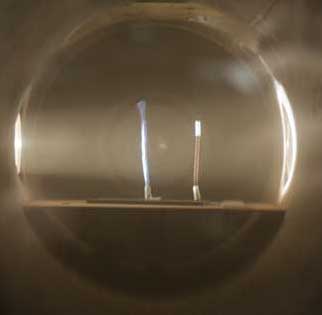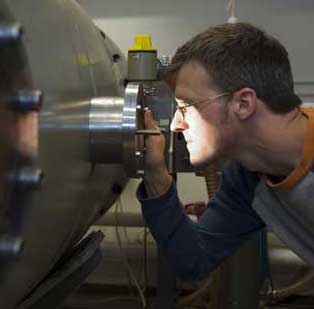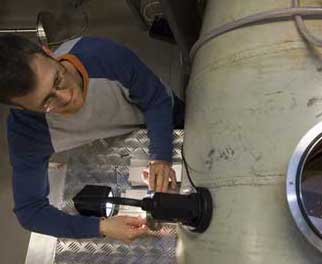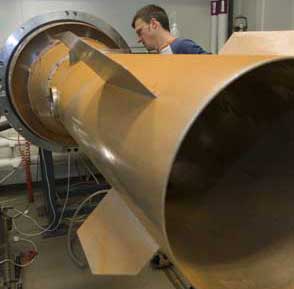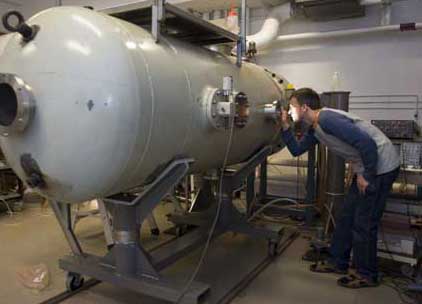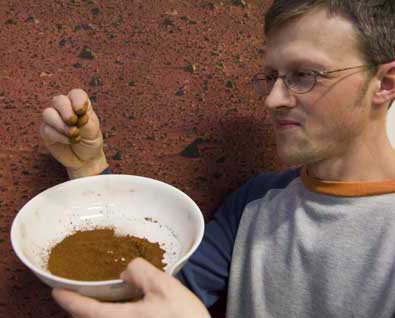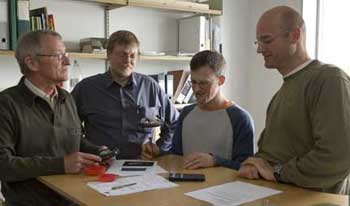Martian dust in the wind
It takes about six monthsto reach the surface of the planet Mars from Earth, but researchers at the University of Århus in Denmark can be there in seconds. They just have to peer inside the porthole windows of the university’s wind tunnel.
Why does Martian dust blow around when it should not?
The answer, my friend, is blowing in a wind tunnel in Denmark.
It takes about six monthsto reach the surface of the planet Mars from Earth, but researchers at the University of Århus in Denmark can be there in seconds. They just have to peer inside the porthole windows of the university’s wind tunnel.
The wind tunnel, a main feature of the university’s Mars Simulation Laboratory (Marslab), looks a lot like a laser weapon from an early James Bond film, but its claim to fame is quite different: It is unique in the world for its ability to hold Martian-like dust in steady circulation at low wind speeds (5 to 10 metres per second).
Marslab’s analytical facilities have been built by a team of biologists, chemists, geologists and physicists, all of whom are focused on researching the red planet. A large poster of Mars covers Marslab’s double doorway. “Just so you know where you are,” says physicist Jon Merrison, smiling.
Jon is one of the researchers responsible for the lab. Inside, he nods to the thin film of reddish brown dust on the floor. “You can actually see it there, too.”
The dust seems to coat all surfaces inside the lab, which resembles a garage aboard the Starship Enterprise. Tubes, coils, shiny gizmos, crinkly insulating foils and tools lie scattered along workbenches.
Martian dust puzzles researchers,and they believe that unlocking its strange properties will help them solve other Martian mysteries, such as whether the planet can harbour life or if it was once like Earth.
For one thing, Martian dust sticks to everything – including itself. It is the most dangerous environmental hazard on Mars. Send anything to the planet’s surface and it will be instantly coated with the powdery, magnetic, electrostatic stuff. The dust causes mechan-ical, chemical, optical and electrical damage and poses a major risk to instruments on Mars.
“If we ever send people to Mars, we need to keep the dust out of their habitat,” explains Merrison. “You get just a little bit of this on yourself, and you’ll never get it off. It’s a sticky, nasty stuff. And it’s definitely not good for your lungs.”
The dust is composed mostly of reddish iron oxide (rust), and the Marslab group can in fact collect sediment that is very similar from a nearby forest. Merrison holds up a bowl of what looks like cocoa powder but is actually the forest dust.
“We stick with this as a reference point,” he says. “Standard NASA (US space programme) Mars analogous dust is different. They collect theirs at the top of a Hawaiian volcano, and the colour of their dust is closer to Martian dust. But our dust is finer, giving us a closer size distribution, and magnetically ours is also more like that of Martian dust.”
Martian dust moves through the air in strange ways.
“There’s an optimum size where particles begin to move from wind, and that should be the same on Earth and Mars,” Merrison says. That size is 100 microns, a grain of sand. Martian dust is much finer – a single micron in size. One aspect of the wind tunnel research is to determine why it is so easily picked up by the wind.
The torpedo-shaped wind tunneldominates the laboratory. Its design enables a sample of Martian air, mostly carbon dioxide at 1 percent of Earth’s air pressure, to circulate indefinitely (see box “A better design”).
“Besides us, NASA has the only other Mars wind tunnel in the world,” says Merrison.
“What’s so special about ours is that we can do the low wind speeds, and as a consequence of this we can observe certain things. We can hold onto the same dust during experiments, therefore we can study how the dust changes properties as it blows around.”
As a result of its wind tunnel work, Marslab is getting very close to understanding why Martian dust performs as it does, he says. Due to its magnetism and electro-static properties, small grains attract each other, forming clumps. The wind picks up these “dust bunnies,” which resemble sand but are much lighter. When they bounce or crash into a surface, they break up again.Lately, Merrison and his colleagues have been designing different wind sensors with the hope of getting them onto upcoming missions to Mars – one of the ultimate goals of Marslab.
“Traditional anemometers work very well on Earth, but the low pressure on Mars, plus the hot and cold extremes, cause them to be inaccurate,” Merrison says.
He unscrews several boltsaround the periphery of the wind tunnel, pulling it apart. As the outer shell rolls smoothly away, it exposes the red-dust covered inner cylinder and two short, pencil thin wire coils, topped with small paper wads. This non-mechanical, primitive instrument – basically a ball on a spring – can be photographed by a Mars rover to reveal the strength of the wind.
“It has to be simple,” Merrison stresses. “Nearly all the best ideas are based on something simple. There isn’t a lot of space on these rovers. They don’t like a lot of extra things on board. And to get something on board a mission, it cannot endanger anything and must weigh next to nothing.”
He points to some other prototypes of this “Telltale” wind sensor, consisting of foil and springs. “How long did it take to make that? A few minutes.”
Marslab hopes toget its Telltale sensor on board the next NASA lander, scheduled for departure in 2007. For the European Space Agency’s next mission, in 2011, the lab is developing a more sophisticated – yet still surprisingly simple – anemometer. It sends out three laser beams, which can measure wind speed and direction and detect dust and its electrical charge. On their fourth prototype of the laser, Marslab scientists can make changes in the workshop and see the results instantly.
“The thing about having a wind tunnel right here is you can have an idea in the morning and then test it in the afternoon, then move on,” says Merrison.
A better design
The Marslab wind tunnel consists mainly of a hollow inner cylinder equipped with a fan on one end, enclosed by an outer shell with concave ends. The fan pushes air down the inner cylinder, where it hits the back wall and returns outside the inner cylinder, and then gets sucked in again by the fan.
The machinery must not interfere in any way with the ultra-fine, magnetic, electrostatic dust, and it must be able to withstand an enclosed atmosphere that is heated and cooled very quickly. Marslab’s first wind tunnel, from 1999, had problems with all of these factors.
In 2003 SKF supplied 6206 HC4 full ceramic deep groove ball bearings for a new version of the unit. These bearings have provided a better design for the wind tunnel, higher wind speeds and a general improvement. “They’ve made a big difference,” says Marslab’s Jon Merrison.
The next step up from this version of the wind tunnel is a bigger one, he says. “We could get a much better flow control, and we could walk around inside a bigger chamber. We could also put a Mars rover inside and test everything against the dust.”




